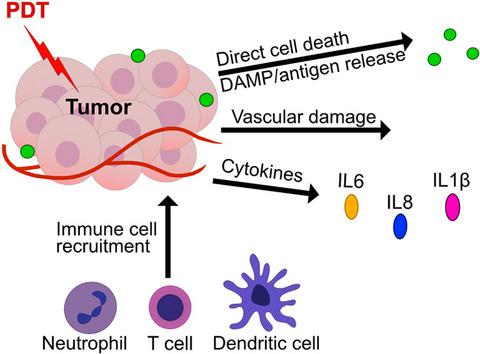当前位置:
X-MOL 学术
›
Photochem. Photobiol.
›
论文详情
Our official English website, www.x-mol.net, welcomes your feedback! (Note: you will need to create a separate account there.)
Photodynamic Therapy and Immune Checkpoint Blockade
Photochemistry and Photobiology ( IF 3.3 ) Pub Date : 2020-07-14 , DOI: 10.1111/php.13300 Gwendolyn M Cramer 1 , Edmund K Moon 2 , Keith A Cengel 1 , Theresa M Busch 1
Photochemistry and Photobiology ( IF 3.3 ) Pub Date : 2020-07-14 , DOI: 10.1111/php.13300 Gwendolyn M Cramer 1 , Edmund K Moon 2 , Keith A Cengel 1 , Theresa M Busch 1
Affiliation

|
Immune checkpoints including PD‐1 and CTLA‐4 help to regulate the intensity and timeframe of the immune response. Since they become upregulated in cancer and prevent sufficient antitumor immunity, monoclonal antibodies against these checkpoints have shown clinical promise for a range of cancers. Multimodal treatment plans combining immune checkpoint inhibitors with other therapies, including photodynamic therapy (PDT), may help to expand treatment efficacy and minimize side effects. PDT's cytotoxic effects are spatially limited by the light activation process, constraining PDT direct effects to the treatment field. The production of damage‐associated molecular patterns and tumor‐associated antigens from PDT can encourage accumulation and maturation of antigen‐presenting cells and reprogram the tumor microenvironment to be more susceptible to therapies targeting immune checkpoints.
中文翻译:

光动力疗法和免疫检查点封锁
包括 PD-1 和 CTLA-4 在内的免疫检查点有助于调节免疫反应的强度和时间范围。由于它们在癌症中上调并阻止足够的抗肿瘤免疫,因此针对这些检查点的单克隆抗体已显示出治疗一系列癌症的临床前景。将免疫检查点抑制剂与其他疗法(包括光动力疗法 (PDT))相结合的多模式治疗计划可能有助于扩大治疗效果并最大限度地减少副作用。PDT 的细胞毒性作用在空间上受到光激活过程的限制,从而限制了 PDT 对治疗领域的直接影响。
更新日期:2020-07-14
中文翻译:

光动力疗法和免疫检查点封锁
包括 PD-1 和 CTLA-4 在内的免疫检查点有助于调节免疫反应的强度和时间范围。由于它们在癌症中上调并阻止足够的抗肿瘤免疫,因此针对这些检查点的单克隆抗体已显示出治疗一系列癌症的临床前景。将免疫检查点抑制剂与其他疗法(包括光动力疗法 (PDT))相结合的多模式治疗计划可能有助于扩大治疗效果并最大限度地减少副作用。PDT 的细胞毒性作用在空间上受到光激活过程的限制,从而限制了 PDT 对治疗领域的直接影响。



























 京公网安备 11010802027423号
京公网安备 11010802027423号